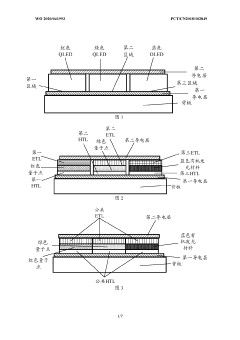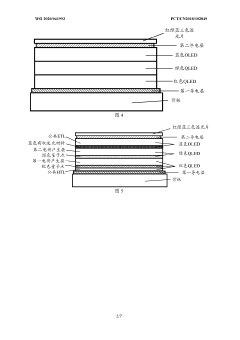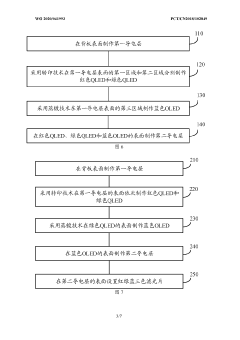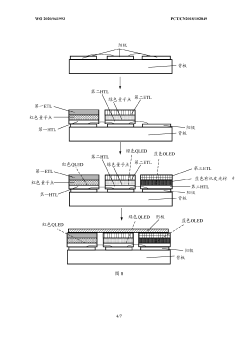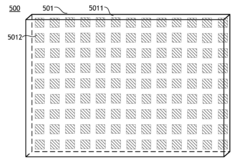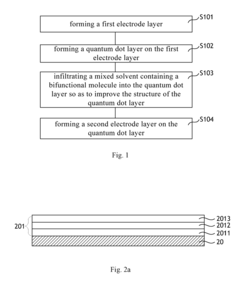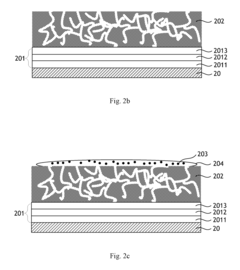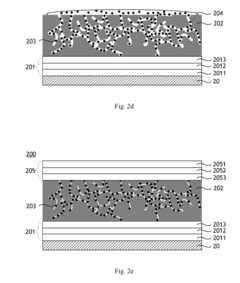How to Choose the Best QLED TV for Your Needs?
JUN 19, 20258 MIN READ
Generate Your Research Report Instantly with AI Agent
Patsnap Eureka helps you evaluate technical feasibility & market potential.
QLED TV Technology Evolution and Objectives
QLED TV technology has undergone significant evolution since its introduction, driven by the pursuit of superior picture quality and enhanced viewing experiences. The journey began with the development of quantum dot technology, which revolutionized color reproduction in displays. Initially, quantum dots were used to enhance the backlight of LCD panels, leading to improved color accuracy and brightness.
As the technology matured, manufacturers focused on refining the quantum dot layer and its integration with other display components. This led to advancements in color volume, peak brightness, and overall picture quality. The evolution of QLED TVs also saw improvements in panel design, with the introduction of direct full-array local dimming and mini-LED backlights, further enhancing contrast and black levels.
One of the key objectives in QLED TV development has been to address the inherent limitations of LCD technology, such as viewing angles and motion handling. Manufacturers have invested in developing new optical films and panel structures to improve off-axis viewing and reduce motion blur, bringing QLED performance closer to that of OLED displays.
Another significant goal has been to enhance energy efficiency while maintaining or improving picture quality. This has led to the development of more efficient quantum dot materials and optimized backlight systems, resulting in TVs that deliver stunning visuals with reduced power consumption.
The evolution of QLED technology has also been driven by the need to support emerging content formats and standards. This includes the implementation of high dynamic range (HDR) technologies, wider color gamuts, and higher refresh rates to accommodate next-generation gaming and video content.
Looking forward, the objectives for QLED TV technology include further improvements in color accuracy, contrast ratios, and peak brightness. There is a push towards developing self-emissive quantum dot displays, which could potentially combine the best aspects of QLED and OLED technologies. Additionally, manufacturers are exploring ways to integrate advanced AI-driven picture processing to optimize image quality in real-time based on content and viewing conditions.
The ongoing evolution of QLED technology aims to provide consumers with an increasingly immersive and lifelike viewing experience, while also addressing practical considerations such as durability, longevity, and environmental impact. As the technology continues to advance, the goal is to offer a compelling alternative to other display technologies, catering to a wide range of consumer needs and preferences in the ever-competitive TV market.
As the technology matured, manufacturers focused on refining the quantum dot layer and its integration with other display components. This led to advancements in color volume, peak brightness, and overall picture quality. The evolution of QLED TVs also saw improvements in panel design, with the introduction of direct full-array local dimming and mini-LED backlights, further enhancing contrast and black levels.
One of the key objectives in QLED TV development has been to address the inherent limitations of LCD technology, such as viewing angles and motion handling. Manufacturers have invested in developing new optical films and panel structures to improve off-axis viewing and reduce motion blur, bringing QLED performance closer to that of OLED displays.
Another significant goal has been to enhance energy efficiency while maintaining or improving picture quality. This has led to the development of more efficient quantum dot materials and optimized backlight systems, resulting in TVs that deliver stunning visuals with reduced power consumption.
The evolution of QLED technology has also been driven by the need to support emerging content formats and standards. This includes the implementation of high dynamic range (HDR) technologies, wider color gamuts, and higher refresh rates to accommodate next-generation gaming and video content.
Looking forward, the objectives for QLED TV technology include further improvements in color accuracy, contrast ratios, and peak brightness. There is a push towards developing self-emissive quantum dot displays, which could potentially combine the best aspects of QLED and OLED technologies. Additionally, manufacturers are exploring ways to integrate advanced AI-driven picture processing to optimize image quality in real-time based on content and viewing conditions.
The ongoing evolution of QLED technology aims to provide consumers with an increasingly immersive and lifelike viewing experience, while also addressing practical considerations such as durability, longevity, and environmental impact. As the technology continues to advance, the goal is to offer a compelling alternative to other display technologies, catering to a wide range of consumer needs and preferences in the ever-competitive TV market.
QLED TV Market Demand Analysis
The QLED TV market has experienced significant growth in recent years, driven by increasing consumer demand for high-quality display technology and enhanced viewing experiences. As consumers seek larger screens with better picture quality, QLED TVs have emerged as a popular choice due to their superior color reproduction, brightness, and contrast ratios compared to traditional LED TVs.
Market research indicates that the global QLED TV market is expected to continue its upward trajectory, with a compound annual growth rate (CAGR) projected to remain strong over the next five years. This growth is attributed to several factors, including the rising disposable income of consumers in developing economies, the increasing adoption of smart home technologies, and the growing preference for premium home entertainment systems.
The demand for QLED TVs is particularly robust in regions such as North America, Europe, and Asia-Pacific, where consumers are more likely to invest in advanced display technologies. In these markets, there is a noticeable trend towards larger screen sizes, with 55-inch and above models gaining popularity among households looking to create immersive home theater experiences.
Another key driver of QLED TV market demand is the expanding content ecosystem. With the proliferation of 4K and HDR content across streaming platforms and broadcast channels, consumers are increasingly seeking display technologies that can fully showcase these high-quality visuals. QLED TVs, with their ability to deliver vibrant colors and deep blacks, are well-positioned to meet this demand.
The gaming industry has also contributed significantly to the growing demand for QLED TVs. As next-generation gaming consoles and PC gaming rigs push the boundaries of graphics capabilities, gamers are looking for displays that can keep up with high refresh rates, low input lag, and superior picture quality. QLED TVs, especially those with gaming-specific features, have become attractive options for this segment of the market.
Environmental concerns and energy efficiency have also played a role in shaping market demand. QLED technology, known for its energy-efficient operation compared to OLED alternatives, appeals to environmentally conscious consumers and those looking to reduce their electricity bills.
As the market evolves, there is an increasing demand for QLED TVs with advanced features such as AI-powered picture optimization, voice control integration, and seamless smart home connectivity. These features not only enhance the viewing experience but also position QLED TVs as central hubs in modern smart homes, further driving consumer interest and market growth.
Market research indicates that the global QLED TV market is expected to continue its upward trajectory, with a compound annual growth rate (CAGR) projected to remain strong over the next five years. This growth is attributed to several factors, including the rising disposable income of consumers in developing economies, the increasing adoption of smart home technologies, and the growing preference for premium home entertainment systems.
The demand for QLED TVs is particularly robust in regions such as North America, Europe, and Asia-Pacific, where consumers are more likely to invest in advanced display technologies. In these markets, there is a noticeable trend towards larger screen sizes, with 55-inch and above models gaining popularity among households looking to create immersive home theater experiences.
Another key driver of QLED TV market demand is the expanding content ecosystem. With the proliferation of 4K and HDR content across streaming platforms and broadcast channels, consumers are increasingly seeking display technologies that can fully showcase these high-quality visuals. QLED TVs, with their ability to deliver vibrant colors and deep blacks, are well-positioned to meet this demand.
The gaming industry has also contributed significantly to the growing demand for QLED TVs. As next-generation gaming consoles and PC gaming rigs push the boundaries of graphics capabilities, gamers are looking for displays that can keep up with high refresh rates, low input lag, and superior picture quality. QLED TVs, especially those with gaming-specific features, have become attractive options for this segment of the market.
Environmental concerns and energy efficiency have also played a role in shaping market demand. QLED technology, known for its energy-efficient operation compared to OLED alternatives, appeals to environmentally conscious consumers and those looking to reduce their electricity bills.
As the market evolves, there is an increasing demand for QLED TVs with advanced features such as AI-powered picture optimization, voice control integration, and seamless smart home connectivity. These features not only enhance the viewing experience but also position QLED TVs as central hubs in modern smart homes, further driving consumer interest and market growth.
QLED vs OLED: Current State and Challenges
QLED (Quantum Dot Light Emitting Diode) and OLED (Organic Light Emitting Diode) are two leading display technologies in the current TV market. Both offer superior picture quality compared to traditional LED-LCD TVs, but they achieve this through different means and have distinct advantages and challenges.
QLED technology, pioneered by Samsung, uses a layer of quantum dots to enhance color and brightness in LCD panels. These nano-sized semiconductor particles emit light of specific wavelengths when excited by electricity, resulting in more vibrant and accurate colors. QLED TVs can achieve higher peak brightness levels, making them ideal for well-lit rooms and HDR content.
On the other hand, OLED technology, primarily championed by LG, uses organic compounds that emit light when an electric current is applied. Each pixel in an OLED display can turn on or off independently, resulting in perfect blacks and infinite contrast ratios. This self-emissive nature also allows for wider viewing angles and faster response times.
The current state of QLED technology shows continuous improvements in color volume and brightness. Recent advancements include the development of more efficient quantum dots and better light management techniques. However, QLED still faces challenges in achieving the deep blacks and pixel-level contrast that OLED can provide.
OLED technology, while excelling in contrast and viewing angles, faces its own set of challenges. These include potential screen burn-in issues, lower peak brightness compared to QLED, and higher production costs, especially for larger screen sizes.
Both technologies are actively addressing their respective weaknesses. QLED is focusing on improving local dimming techniques to enhance contrast, while OLED manufacturers are working on increasing brightness and implementing measures to mitigate burn-in risks.
The choice between QLED and OLED often depends on specific viewing environments and personal preferences. QLED's higher brightness makes it more suitable for brightly lit rooms, while OLED's superior contrast and black levels shine in darker viewing conditions.
As these technologies continue to evolve, we can expect further improvements in picture quality, energy efficiency, and durability. The competition between QLED and OLED is driving innovation in the TV industry, ultimately benefiting consumers with better viewing experiences.
QLED technology, pioneered by Samsung, uses a layer of quantum dots to enhance color and brightness in LCD panels. These nano-sized semiconductor particles emit light of specific wavelengths when excited by electricity, resulting in more vibrant and accurate colors. QLED TVs can achieve higher peak brightness levels, making them ideal for well-lit rooms and HDR content.
On the other hand, OLED technology, primarily championed by LG, uses organic compounds that emit light when an electric current is applied. Each pixel in an OLED display can turn on or off independently, resulting in perfect blacks and infinite contrast ratios. This self-emissive nature also allows for wider viewing angles and faster response times.
The current state of QLED technology shows continuous improvements in color volume and brightness. Recent advancements include the development of more efficient quantum dots and better light management techniques. However, QLED still faces challenges in achieving the deep blacks and pixel-level contrast that OLED can provide.
OLED technology, while excelling in contrast and viewing angles, faces its own set of challenges. These include potential screen burn-in issues, lower peak brightness compared to QLED, and higher production costs, especially for larger screen sizes.
Both technologies are actively addressing their respective weaknesses. QLED is focusing on improving local dimming techniques to enhance contrast, while OLED manufacturers are working on increasing brightness and implementing measures to mitigate burn-in risks.
The choice between QLED and OLED often depends on specific viewing environments and personal preferences. QLED's higher brightness makes it more suitable for brightly lit rooms, while OLED's superior contrast and black levels shine in darker viewing conditions.
As these technologies continue to evolve, we can expect further improvements in picture quality, energy efficiency, and durability. The competition between QLED and OLED is driving innovation in the TV industry, ultimately benefiting consumers with better viewing experiences.
QLED TV Features and Specifications
01 QLED display structure and manufacturing
QLED (Quantum Dot Light Emitting Diode) TV technology involves the use of quantum dots to enhance color and brightness. The manufacturing process includes depositing quantum dot layers, electrode formation, and encapsulation techniques to create efficient and vibrant displays.- QLED display structure and manufacturing: This category focuses on the structural design and manufacturing processes of QLED (Quantum Dot Light Emitting Diode) displays. It includes innovations in quantum dot layers, light-emitting layers, and electrode configurations. The manufacturing techniques aim to improve display quality, efficiency, and durability of QLED TVs.
- Color enhancement and light management: This area covers technologies for improving color reproduction and light management in QLED TVs. It includes methods for enhancing color gamut, brightness, and contrast using quantum dot materials and advanced optical designs. These innovations aim to provide more vivid and accurate color representation in QLED displays.
- Energy efficiency and power management: This category encompasses technologies aimed at improving the energy efficiency of QLED TVs. It includes innovations in power management systems, low-power display modes, and energy-saving algorithms. These advancements help reduce power consumption while maintaining high display quality.
- Image processing and display algorithms: This area focuses on software and algorithmic improvements for QLED TVs. It includes advanced image processing techniques, upscaling algorithms, and display optimization methods. These innovations enhance picture quality, reduce motion blur, and improve overall viewing experience on QLED displays.
- QLED TV design and user interface: This category covers innovations in the physical design and user interface of QLED TVs. It includes advancements in slim and bezel-less designs, smart TV functionalities, and intuitive user interfaces. These improvements enhance the aesthetic appeal and user experience of QLED TVs.
02 Quantum dot materials and compositions
Development of specific quantum dot materials and compositions is crucial for QLED performance. This includes research into various semiconductor nanocrystals, their synthesis methods, and optimization of their optical properties to achieve superior color gamut and efficiency in QLED displays.Expand Specific Solutions03 QLED backlight and color enhancement
QLED TVs often utilize quantum dots in the backlight system to enhance color reproduction. This involves integrating quantum dot films or components into LED backlights to improve color purity and expand the color gamut of the display.Expand Specific Solutions04 QLED panel design and optical improvements
Innovations in QLED panel design focus on improving optical characteristics such as light extraction efficiency, viewing angles, and contrast ratios. This includes developing new pixel structures, light guide designs, and anti-reflection technologies specific to QLED displays.Expand Specific Solutions05 QLED TV image processing and control systems
Advanced image processing algorithms and control systems are developed for QLED TVs to optimize picture quality. This includes techniques for color management, HDR processing, and adaptive brightness control to fully leverage the capabilities of quantum dot technology in various viewing conditions.Expand Specific Solutions
Key QLED TV Manufacturers and Competitors
The QLED TV market is in a mature growth phase, with significant competition among major players. The global QLED TV market size is projected to reach substantial figures, driven by increasing demand for high-quality displays. Technologically, QLED TVs are well-established, with ongoing innovations focused on enhancing picture quality, energy efficiency, and smart features. Key players like Samsung, TCL, and Hisense are at the forefront, with companies such as BOE Technology Group, Sharp Corp., and Skyworth-RGB Electronics also making significant contributions. These firms are investing heavily in R&D to improve quantum dot technology, color accuracy, and overall viewing experience, indicating a highly competitive and technologically advanced landscape in the QLED TV sector.
BOE Technology Group Co., Ltd.
Technical Solution: BOE has developed advanced QLED technology using quantum dot materials to enhance color performance. Their QLED TVs feature a quantum dot film layer that converts blue LED backlight into pure red and green light, resulting in a wider color gamut and improved color accuracy. BOE's QLED panels also incorporate local dimming technology to enhance contrast ratios and deliver deeper blacks. The company has invested in research to improve quantum dot stability and longevity, addressing common concerns about QLED technology.
Strengths: Wide color gamut, high brightness, and improved energy efficiency. Weaknesses: Potential for color shift over time and higher production costs compared to traditional LED-LCD TVs.
Sharp Corp.
Technical Solution: Sharp has developed its own QLED technology called AQUOS Quantum Dot. This technology utilizes a quantum dot enhancement film (QDEF) to improve color reproduction and brightness. Sharp's QLED TVs feature a triluminos display that uses quantum dots to produce purer and more precise colors. The company has also integrated its proprietary X4 Master Engine Pro image processor to optimize picture quality and upscale content to near-4K resolution. Sharp's QLED TVs incorporate local dimming technology to enhance contrast and black levels.
Strengths: Excellent color accuracy and brightness, advanced image processing capabilities. Weaknesses: Limited market presence compared to larger competitors, potentially higher price points.
Core QLED Innovations and Patents
Display screen using hybrid light-emitting diode and manufacturing method therefor
PatentWO2020041993A1
Innovation
- Using a hybrid light-emitting diode structure, combining red quantum dot light-emitting diodes (QLED) and green quantum dot light-emitting diodes (QLED) with blue organic light-emitting diodes (OLED), by designing the structures and structures of red QLED, green QLED and blue OLED respectively. Materials to improve the color gamut range and lifespan of the display screen.
QLED device and manufacturing method thereof, QLED display panel and QLED display device
PatentActiveUS20180294414A1
Innovation
- A method involving the infiltration of a mixed solvent containing bifunctional molecules into the quantum dot layer to form bridges between loose quantum dots, improving the compactness and regularity of both the surface and internal structure, using a process that includes temperature adjustment, rotation, and annealing to enhance solubility and diffusion.
QLED TV Energy Efficiency and Sustainability
Energy efficiency and sustainability have become increasingly important factors in consumer electronics, and QLED TVs are no exception. When choosing the best QLED TV for your needs, considering these aspects can lead to both environmental and economic benefits.
QLED TVs generally offer improved energy efficiency compared to traditional LED-LCD models. This is primarily due to their use of quantum dots, which enhance color and brightness while consuming less power. Many QLED TVs now come with advanced power-saving features, such as automatic brightness adjustment and standby modes that significantly reduce energy consumption when the TV is not in active use.
Manufacturers have been making strides in improving the overall sustainability of QLED TVs. This includes using more eco-friendly materials in production, reducing packaging waste, and implementing more efficient manufacturing processes. Some companies have also introduced recycling programs for old TVs and are working towards using more recycled materials in new models.
When evaluating QLED TVs for energy efficiency, look for models with high Energy Star ratings. These ratings provide a standardized measure of energy consumption and can help you compare different models. Additionally, many QLED TVs now display their annual energy consumption estimates, allowing consumers to make more informed decisions based on long-term energy costs.
The size of the TV also plays a crucial role in energy consumption. Larger screens typically consume more power, so it's important to balance your desire for a big screen with energy efficiency considerations. Some manufacturers offer energy-efficient options even in larger sizes, so it's worth comparing different models within your preferred size range.
Smart features in QLED TVs can contribute to both energy efficiency and sustainability. For instance, some models offer power-saving modes that can be activated through voice commands or smartphone apps. These features allow for more precise control over energy usage, potentially leading to significant savings over time.
When considering sustainability, it's also worth looking into the manufacturer's commitment to environmental practices. Some companies have pledged to reduce their carbon footprint, use renewable energy in production, or implement take-back programs for old electronics. Choosing a TV from a manufacturer with strong environmental policies can contribute to broader sustainability efforts in the electronics industry.
In conclusion, when selecting a QLED TV, considering energy efficiency and sustainability can lead to a more environmentally responsible choice without compromising on picture quality or features. By prioritizing these factors alongside performance and price, consumers can make a decision that aligns with both their viewing needs and environmental values.
QLED TVs generally offer improved energy efficiency compared to traditional LED-LCD models. This is primarily due to their use of quantum dots, which enhance color and brightness while consuming less power. Many QLED TVs now come with advanced power-saving features, such as automatic brightness adjustment and standby modes that significantly reduce energy consumption when the TV is not in active use.
Manufacturers have been making strides in improving the overall sustainability of QLED TVs. This includes using more eco-friendly materials in production, reducing packaging waste, and implementing more efficient manufacturing processes. Some companies have also introduced recycling programs for old TVs and are working towards using more recycled materials in new models.
When evaluating QLED TVs for energy efficiency, look for models with high Energy Star ratings. These ratings provide a standardized measure of energy consumption and can help you compare different models. Additionally, many QLED TVs now display their annual energy consumption estimates, allowing consumers to make more informed decisions based on long-term energy costs.
The size of the TV also plays a crucial role in energy consumption. Larger screens typically consume more power, so it's important to balance your desire for a big screen with energy efficiency considerations. Some manufacturers offer energy-efficient options even in larger sizes, so it's worth comparing different models within your preferred size range.
Smart features in QLED TVs can contribute to both energy efficiency and sustainability. For instance, some models offer power-saving modes that can be activated through voice commands or smartphone apps. These features allow for more precise control over energy usage, potentially leading to significant savings over time.
When considering sustainability, it's also worth looking into the manufacturer's commitment to environmental practices. Some companies have pledged to reduce their carbon footprint, use renewable energy in production, or implement take-back programs for old electronics. Choosing a TV from a manufacturer with strong environmental policies can contribute to broader sustainability efforts in the electronics industry.
In conclusion, when selecting a QLED TV, considering energy efficiency and sustainability can lead to a more environmentally responsible choice without compromising on picture quality or features. By prioritizing these factors alongside performance and price, consumers can make a decision that aligns with both their viewing needs and environmental values.
Consumer Buying Guide for QLED TVs
When selecting a QLED TV, consumers should consider several key factors to ensure they choose the best model for their specific needs. Screen size is a crucial consideration, as it directly impacts the viewing experience. The ideal size depends on the room dimensions and viewing distance, with larger screens generally offering a more immersive experience.
Picture quality is another critical aspect, encompassing factors such as resolution, color accuracy, and contrast ratio. QLED TVs are known for their vibrant colors and high brightness levels, making them suitable for both dark and well-lit rooms. Consumers should look for models with 4K or 8K resolution for sharp, detailed images.
HDR (High Dynamic Range) support is essential for enhancing contrast and color range. Look for TVs that support popular HDR formats like HDR10, HDR10+, or Dolby Vision to ensure compatibility with a wide range of content.
Smart features and connectivity options are increasingly important in modern TVs. Consider the operating system, available apps, and voice control capabilities. Some QLED TVs offer advanced features like built-in smart home integration or gaming-specific modes.
Audio quality should not be overlooked, as it significantly contributes to the overall viewing experience. While many consumers opt for separate sound systems, a TV with good built-in speakers can be beneficial for those with space constraints or simpler setups.
Refresh rate is particularly important for viewers who enjoy fast-paced content like sports or action movies, or for gamers. Higher refresh rates, such as 120Hz, provide smoother motion and reduced blur.
Design and aesthetics may also play a role in the decision-making process. QLED TVs often feature slim profiles and minimal bezels, which can enhance the overall look of a room. Some models offer unique design features like ambient modes that display artwork when the TV is not in use.
Finally, consider the brand reputation and after-sales support. Established brands often provide better warranty terms and customer service, which can be crucial for long-term satisfaction with the purchase.
By carefully evaluating these factors and prioritizing based on individual preferences and needs, consumers can make an informed decision when choosing the best QLED TV for their home entertainment setup.
Picture quality is another critical aspect, encompassing factors such as resolution, color accuracy, and contrast ratio. QLED TVs are known for their vibrant colors and high brightness levels, making them suitable for both dark and well-lit rooms. Consumers should look for models with 4K or 8K resolution for sharp, detailed images.
HDR (High Dynamic Range) support is essential for enhancing contrast and color range. Look for TVs that support popular HDR formats like HDR10, HDR10+, or Dolby Vision to ensure compatibility with a wide range of content.
Smart features and connectivity options are increasingly important in modern TVs. Consider the operating system, available apps, and voice control capabilities. Some QLED TVs offer advanced features like built-in smart home integration or gaming-specific modes.
Audio quality should not be overlooked, as it significantly contributes to the overall viewing experience. While many consumers opt for separate sound systems, a TV with good built-in speakers can be beneficial for those with space constraints or simpler setups.
Refresh rate is particularly important for viewers who enjoy fast-paced content like sports or action movies, or for gamers. Higher refresh rates, such as 120Hz, provide smoother motion and reduced blur.
Design and aesthetics may also play a role in the decision-making process. QLED TVs often feature slim profiles and minimal bezels, which can enhance the overall look of a room. Some models offer unique design features like ambient modes that display artwork when the TV is not in use.
Finally, consider the brand reputation and after-sales support. Established brands often provide better warranty terms and customer service, which can be crucial for long-term satisfaction with the purchase.
By carefully evaluating these factors and prioritizing based on individual preferences and needs, consumers can make an informed decision when choosing the best QLED TV for their home entertainment setup.
Unlock deeper insights with Patsnap Eureka Quick Research — get a full tech report to explore trends and direct your research. Try now!
Generate Your Research Report Instantly with AI Agent
Supercharge your innovation with Patsnap Eureka AI Agent Platform!
